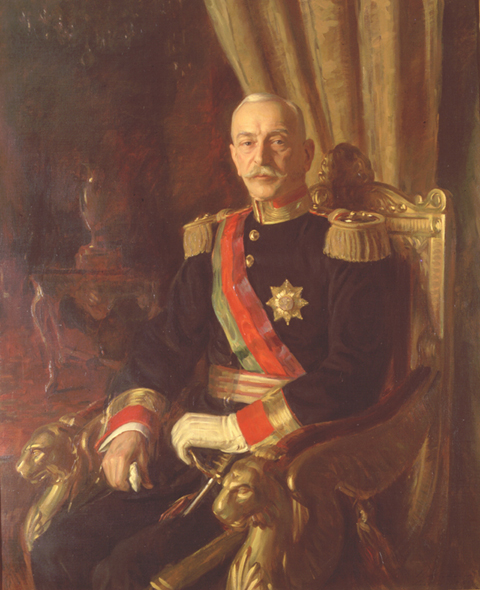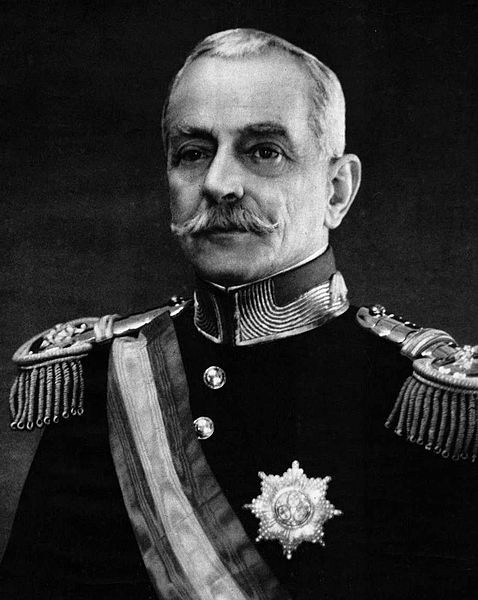<Back to Index>
- 11th President of Portugal António Óscar Fragoso Carmona, 1869
PAGE SPONSOR


António Óscar Fragoso Carmona (often called António Óscar de Fragoso Carmona; Lisbon, 24 November 1869 - Lisbon, 18 April 1951) was the 11th President of Portugal (1926 – 1951), having been Minister of War in 1923.
Carmona was a republican and a freemason and was a quick adherent to the proclamation of the republic, on 5 October 1910. He was however never a sympathizer of the democratic form of government and, as he later would confess in a interview to António Ferro, he only voted for the first time at the National Plebiscite of 1933. During the First Republic he was briefly War Minister in the Ministry of António Ginestal Machado in 1923. Unlike the popular marshal Gomes da Costa, Carmona had not fought in World War I.
In January 1914 he married Maria do Carmo Ferreira da Silva (Chaves, 28 September 1878 - 13 March 1956), daughter of Germano da Silva and wife Engrácia de Jesus. With this marriage he legitimized their three children.
Carmona was very active in the 28th May revolution of 1926 that overthrew the First Republic. The first Council President, commandant José Mendes Cabeçadas, of democratic tendency, was succeeded in June by Manuel de Oliveira Gomes da Costa, also a supporter of parliamentary democracy. Carmona, who had been the Minister for Foreign Affairs between 3 June and 6 July, was the leader of the most conservative and anti - democratic wing of the military regime. On 9 July, Carmona led a counter coup and named himself President. He was formally elected to the office in 1928 as the only candidate.
In 1928 Carmona appointed António de Oliveira Salazar as Minister of Finances. Impressed by Salazar's charisma and qualities Carmona nominated Salazar as Prime Minister in 1932.
In 1933, with a new constitution, the "Estado Novo" was finally officially established. On paper, the new document confirmed the near dictatorial powers Carmona had exercised since 1928. However, in practice he was now little more than a figurehead; Salazar held the real power. He was reelected without opposition in 1935 and 1942 for seven year terms. In 1935 he signed the law that forbade Freemasonary in Portugal, with dismay due to his freemason past.
Although the democratic opposition was allowed to contest elections after World War II, Carmona was not on friendly terms with it. When the opposition demanded that the elections be delayed in order to give it more time to organize, Carmona turned it down.
However there were widespread rumors that Carmona supported the failed military uprising in 1948, which was led by general José Marques Godinho, to overthrow Salazar, with the condition that he would remain as President of the Republic. Probably to end these rumors Carmona finally accepted the title of marshal.
In 1949, Carmona, aged 79 years old, sought his fourth term as president. For the first time, he actually faced an opponent in General José Norton de Matos. However, after the regime refused to grant Matos freedom to actually run a campaign, he pulled out of the race on February 12, handing Carmona another term.
Carmona died two years later, in 1951, after 24 years in the Presidency of the Republic. He was buried in the Church of Santa Engrácia, National Pantheon, in Lisbon.
Carmona wrote a book of rules for the Cavalry School in 1913.
The town of Uíge, Angola, was called Carmona after him. It had this name until 1975 when the Portuguese Overseas Province of Angola became independent.
He is the grand - uncle of the former Mayor of Lisbon Carmona Rodrigues (2004 – 2007).